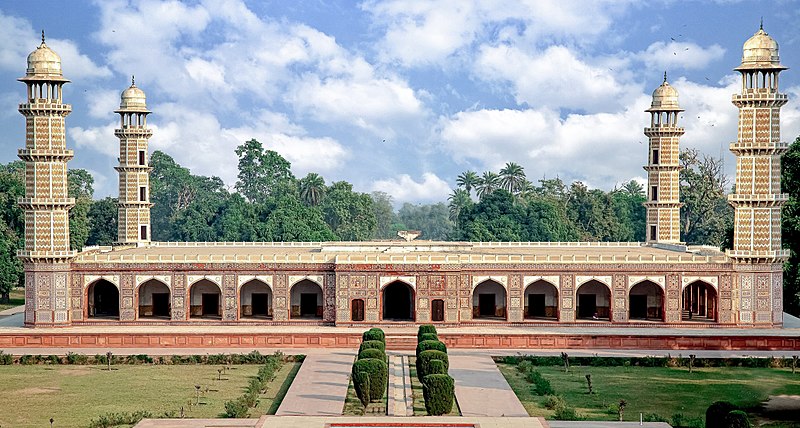As we were talking about the historical places of Pakistan. So this is my 4th post and in this post I want to share the information about the Tomb of Jahangi. This is a good place to visit. I visited this place when I was going to meet my friend yasir. He lives in shaddra and the Tomb of Jahangi is also situated near the shaddra. So lets talk about the famous place which is know as Tomb of Jahangir.
Tomb of Jahangir
 |
Tomb of Jahangir
Location:
The tomb is situated in Shahdara Bagh, northwest of the Walled City of Lahore. The tomb is situated over the River Ravi from Lahore, in what was a country zone known for its various joy gardens. The tomb in situated in Nur Jahan's pleasure garden, the Dilkusha Garden, that had been spread out in 1557. The Tomb of Asif Khan, worked in 1645, and the Akbari Sarai, worked in 1637, are found promptly west of Jahangir's tomb complex, and the three structure a group arranged on an east–west pivot. The remainder of the Shahdara Bagh landmarks, the tomb of Jahangir's better half Nur Jahan is found slight southwest of Asif Khan's tomb.
Background:
The tomb was worked for Emperor Jahangir, who controlled the Mughal Empire from 1605 to 1627 C.E.. The head passed on in the lower regions of Kashmir close to the town of Rajauri on 28 October 1627. A burial service parade moved his body from Kashmir and showed up in Lahore on Friday, 12 November 1627. The Dilkusha Garden in which he was covered was a "most loved spot" of Jahangir and his significant other Nur Jahan, when they lived in Lahore. His child, the new Mughal Emperor Shah Jahan, requested that a "catacomb befitting an Emperor" ought to be worked in his dad's respect to entomb his remaining parts.
 |
|
|
History:
In spite of the fact that contemporary students of history trait development of the tomb to Jahangir's child Shah Jahan, the tomb may have been the consequence of Nur Jahan's vision. Taking motivation from her dad's entombment place, she is said to have structured the tomb in 1627, and perhaps helped subsidize it. Development began in 1627, requiring ten years for fruition, and cost Rs 10 Lakh.
Fix works were embraced at the tomb in 1814 as indicated by Sikh court records. The tomb complex, be that as it may, was likewise contaminated under Sikh guideline when they were looted by the military of Ranjit Singh, with building materials utilized for design of the Golden Temple in Amritsar. The plundered grounds were then changed over for use as a private home for an official in the military of Ranjit Singh, Señor Oms, who was otherwise called Musa Sahib. Ranjit Singh further tainted the catacomb again when he requested that Musa Sahib be covered on the tomb's grounds in the wake of passing on from cholera in 1828. By 1880, gossip had started circling which claimed that the tomb used to be beaten by an arch or second story that was taken by Ranjit Singh's military, however no proof has been found to recommend that a vault or second story at any point existed at the tomb.
The Shahdara troupe of landmarks endured further under British standard, when a railroad line was worked between the tombs of Asif Khan and Nur Jahan. The site was then fixed by the British between 1889-1890.
Flooding from the close by River Ravi compromised or harmed the site in 1867, 1947, 1950, 1954, 1955, 1957, 1958, 1959, 1962, 1966, 1973, 1976, 1988, and 2010. The site continued water harm during flooding in 1988 that secured a significant part of the site in 10 feet of water for 5 days.
Fix works were embraced at the tomb in 1814 as indicated by Sikh court records. The tomb complex, be that as it may, was likewise contaminated under Sikh guideline when they were looted by the military of Ranjit Singh, with building materials utilized for design of the Golden Temple in Amritsar. The plundered grounds were then changed over for use as a private home for an official in the military of Ranjit Singh, Señor Oms, who was otherwise called Musa Sahib. Ranjit Singh further tainted the catacomb again when he requested that Musa Sahib be covered on the tomb's grounds in the wake of passing on from cholera in 1828. By 1880, gossip had started circling which claimed that the tomb used to be beaten by an arch or second story that was taken by Ranjit Singh's military, however no proof has been found to recommend that a vault or second story at any point existed at the tomb.
The Shahdara troupe of landmarks endured further under British standard, when a railroad line was worked between the tombs of Asif Khan and Nur Jahan. The site was then fixed by the British between 1889-1890.
Flooding from the close by River Ravi compromised or harmed the site in 1867, 1947, 1950, 1954, 1955, 1957, 1958, 1959, 1962, 1966, 1973, 1976, 1988, and 2010. The site continued water harm during flooding in 1988 that secured a significant part of the site in 10 feet of water for 5 days.
 |
Emperor Jahangir forbade the construction of a dome over his tomb
|
Comments
Post a Comment